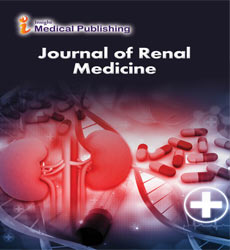The Role of Laparoscopic Donor Nephrectomy in Modern Kidney Transplant Surgery
Daniel Ali*
Department of Medicine, Midwestern University, Indianapolis, USA
- *Corresponding Author:
- Daniel Ali
Department of Medicine, Indiana University School of Medicine, Indianapolis,
USA,
E-mail: ali@outlook.com
Received date: April 06, 2024, Manuscript No. IPJRM-24-19158; Editor assigned date: April 09, 2024, PreQC No. IPJRM-24-19158 (PQ); Reviewed date: April 23, 2024, QC No. IPJRM-24-19158; Revised date: April 30, 2024, Manuscript No. IPJRM-24-19158 (R); Published date: May 07, 2024, DOI: 10.36648/ipjrm.7.3.22
Citation: Ali D (2024) The Role of Laparoscopic Donor Nephrectomy in Modern Kidney Transplant Surgery. Jour Ren Med Vol. 7 No.3: 22.
Description
A kidney transplant is a million people's lifesaver with End- Stage Renal Disease (ESRD) around the globe. This intricate medical procedure not only enhances quality of life but also extends survival rates significantly. It represent the remarkable synergy between medical expertise, technological modification, and the selflessness of donors and their families. As we continue to unravel the complexities of transplantation, let us strive to overcome challenges, expand access to lifesaving treatments.
Understanding kidney transplantation
Kidney transplantation includes the careful situation of a healthy kidney from a donor who is alive or dead into a recipient whose kidneys have failed irreversibly. This procedure offers a superior alternative to dialysis, addressing the root cause of kidney failure and restoring renal function. Successful kidney transplantation grants recipients newfound freedom from the burdensome routine of dialysis sessions and dietary restrictions. Living donor kidney transplantation represents a remarkable feat of altruism and medical advancement. Family members, friends, or even strangers willingly donate one of their kidneys to save the life of another. The compatibility between donor and recipient is meticulously assessed to ensure optimal outcomes and minimize the risk of rejection. Advances in surgical techniques, such as laparoscopic donor nephrectomy, have made the process safer and less invasive for living donors. Deceased donor kidney transplantation plays a vital role in addressing the immense demand for organs. Organ procurement organizations work tirelessly to identify suitable donors and facilitate the transplantation process. Preservation techniques and organ allocation algorithms have improved outcomes and increased the pool of available organs. However, challenges such as organ shortage and logistical hurdles persist, underscoring the need for continued mutation and collaboration in the field. One of the most significant challenges in kidney transplantation is the risk of rejection, wherein the beneficiary's resistant framework distinguishes the relocated organ as foreign and mounts an immune response. Immunosuppressive medications play a pivotal role in preventing rejection, but they come with their own set of problems, such as more susceptibility to infections and adverse effects on other organs. Immunosuppressive therapy must be used while weighing the danger of rejection remains a delicate task for transplant physicians.
Advancements in transplantation
Recent advancements in transplantation immunology have revolutionized the field of kidney transplantation. Targeted immunosuppressive therapies, such as monoclonal antibodies and co-stimulation blockade agents, offer more precise and effective immune modulation, reducing the incidence of rejection while minimizing side effects. Furthermore, the advent of tolerance-inducing protocols holds promise for achieving immune tolerance without the need for lifelong immunosuppression, potentially transforming the landscape of kidney transplantation. Despite the remarkable progress in kidney transplantation, numerous challenges persist. Organ shortage remains a critical issue, exacerbated by disparities in access to transplantation and the aging donor pool. Improving organ procurement and allocation strategies, expanding living donor programs, and harnessing emerging technologies like organ bioengineering offer avenues for addressing this challenge. Moreover, enhancing long-term graft survival and minimizing the side effects of immunosuppression are areas ripe for innovation and research. Beyond its medical implications, kidney transplantation has profound societal and economic ramifications. It enables recipients to lead more productive lives, contribute to their communities, and reduce healthcare costs associated with long-term dialysis. Furthermore, the generosity of living donors fosters a culture of altruism and solidarity, underscoring the interconnectedness of humanity. The route of kidney transplantation traces all the way back to antiquated civilization with early endeavors kept in legendary texts and authentic records.The development of immunosuppressive drugs, such as cyclosporine, revolutionized the field by mitigating the risk of rejection and improving graft survival rates. Subsequent refinements in surgical techniques, organ preservation methods, and post-transplant care further propelled the success of kidney transplantation. Despite remarkable advancements, kidney transplantation continues to face formidable challenges. Moreover, the complexities of immunological compatibility and the risk of rejection necessitate vigilant monitoring and tailored therapeutic interventions. Ethical dilemmas surrounding organ allocation, living donation, and the allocation of healthcare resources further underscore the multifaceted nature of kidney transplantation.
Open Access Journals
- Aquaculture & Veterinary Science
- Chemistry & Chemical Sciences
- Clinical Sciences
- Engineering
- General Science
- Genetics & Molecular Biology
- Health Care & Nursing
- Immunology & Microbiology
- Materials Science
- Mathematics & Physics
- Medical Sciences
- Neurology & Psychiatry
- Oncology & Cancer Science
- Pharmaceutical Sciences
